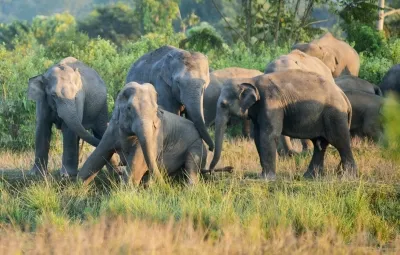How has Tamil Nadu’s wild elephant population increased to 3,170?

Synopsis
Key Takeaways
- Tamil Nadu's wild elephant population has reached 3,170.
- The increase of 107 elephants demonstrates effective conservation efforts.
- The state has implemented scientific monitoring and community involvement.
- Technological advancements aid in tracking and protecting elephants.
- Collaboration with Karnataka ensures comprehensive data collection.
Chennai, Oct 7 (NationPress) The wild elephant population in Tamil Nadu has surged to 3,170, reflecting an increase of 107 from the last estimate of 3,063, as per the Third Synchronised Elephant Population Estimation (2025) report published on Tuesday.
The announcement was made by Forests and Khadi Minister R.S. Raja Kannappan during the celebrations of Wildlife Week in Chennai.
The report indicates that the Mudumalai Tiger Reserve has the highest elephant density in the state, followed closely by the Gudalur Forest Division and Anamalai Tiger Reserve.
Minister Raja Kannappan emphasized that this growth signifies Tamil Nadu’s enduring commitment to safeguarding these magnificent creatures through a blend of scientific oversight and community involvement.
“This ongoing increase showcases Tamil Nadu's dedication to wildlife management, which is both scientifically informed and community-focused,” he stated while presenting the report.
Officials underscored the proactive measures taken by the state, including establishing elephant reserves, extensive habitat restoration, the elimination of invasive species, and social support programs for mahout families, such as the specialized Mahout Villages in Mudumalai and Anamalai.
Supriya Sahu, the Additional Chief Secretary for Environment, Climate Change and Forests, highlighted that Tamil Nadu has established the Agasthyamalai Elephant Reserve, notified the Thanthai Periyar and Cauvery South Wildlife Sanctuaries, and enhanced protection over more than 2.8 lakh hectares of elephant habitat.
Technological advancements—including real-time tracking and surveillance—have been expanded to mitigate conflict and protect migration corridors.
The synchronized estimation was carried out in collaboration with Karnataka from May 23 to 25 to ensure consistent data across shared elephant habitats.
This comprehensive survey, spanning 26 forest divisions, including tiger reserves, wildlife sanctuaries, territorial divisions, and one national park, involved over 2,000 forest personnel and volunteers.
Data collection utilized three established scientific techniques: block count, line-transect (dung count), and waterhole count, across 681 sample blocks covering 3,261 sq km.
The overall elephant density was determined to be 0.35 per sq km. Adult elephants constituted 44 percent of the total population, with a male-to-female ratio of 1:1.77 and an adult female-to-calf ratio of 1:0.50.
Senior officials, including Principal Chief Conservator of Forests Srinivas R. Reddy and Chief Wildlife Warden Rakesh Kumar Dogra, emphasized the importance of enhancing habitat restoration, corridor protection, conflict resolution, and community engagement to maintain the increasing trend of elephant numbers in the state.










